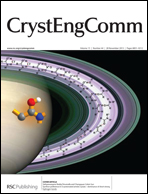Controllable organic-phase synthesis of cuboidal CoO mesocrystals and their magnetic properties†
Abstract
A one-pot process is proposed for the synthesis of cuboidal CoO mesocrystals via the decomposition of cobalt(II) oleate complexes in the presence of oleic acid, water, sodium oleate, and high boiling point (b.p.) organic solvents. The formation of faceted mesocrystals is attributed to the preferential attachment of sodium oleate on the {100} planes of the CoO structure. Meanwhile, the effective aggregation and fusion of the primary nanoparticles is attributed to the presence of free oleic acid and water. It is shown that the size of the mesocrystal cuboids can be tuned between approximately 60 nm and 200 nm by adjusting the ratio of sodium oleate to cobalt oleate and choosing an appropriate high b.p. organic solvent. The as-prepared and aged (45 days) CoO mesocrystals exhibit spontaneous magnetization at low temperatures, as a result of residual spins. The additional peak found in the ZFC curve of the aged mesocrystals at 54 K suggests that surface oxidation leads to the formation of a Co3O4 shell in which symmetry-breaking Co3+ cations enhance the TN. Finally, the S-shaped magnetization regions and vertical shifts of the field-cooled loops in the hysteresis curves of the as-prepared and aged mesocrystals indicate that the residual spins are either rotatable or tightly pinned by the antiferromagnetic lattices.


 Please wait while we load your content...
Please wait while we load your content...